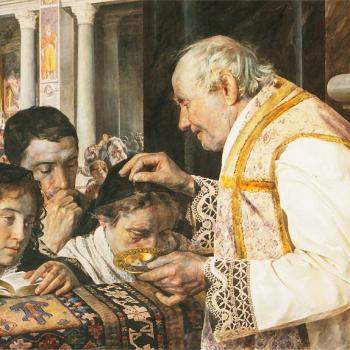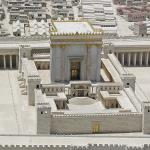Perhaps it is because I have lived in New Orleans for the past three years, but the name of biblical scholar Brant Pitre has become well known to me. He teaches at Notre Dame Seminary in New Orleans, and just about every young adult Catholic I know has met him, read him or listened to his tapes. His recent book signing of “Jesus and the Jewish Roots of the Eucharist” was a major event for many of my friends. The reason seems to be that, like his intellectual mentor Scott Hahn, Pitre has a lively presentation style combined with an active faith life. The combination is attractive to many.
Yet I have always remained intellectually removed from Pitre as I have from Hahn. Aside from reasons I have mentioned before, Kavin Rowe’s recent negative review of Pitre’s book in “First Things” coupled with the Pope’s “Jesus of Nazareth: Part Two” caused further concern for me about his scholarship.
My problem has to do with the so-called “fourth cup” theory of the Last Supper. I can remember when I was in high school, driving into El Paso, Texas, listening to Scott Hahn’s tape on the meaning of the Eucharist. You can find the full text here if you want to read it. Rowe summarizes:
The question naturally arises: If Jesus wanted to declare God’s love by means of this ritual, why didn’t he finish it? As many scholars have noticed, later Jewish sources tell us that standard practice at the Passover meal included four cups, each one of which was drunk at a specific point in the celebration. The final cup was to be consumed in conjunction with the reading of the Psalms of praise (Psalms 115-118, the Hallel) and served as both a “thanksgiving sacrifice” and a “cup of praise.” But there is no fourth cup at the Last Supper.
The rest may be known to you. The fourth cup, say Hahn and Pitre, was drunk by Jesus on the cross when he says “I thirst.” After drinking, he says, “it is finished.” What was finished? Hahn explains:
They put a sponge full of the sour wine on hyssop and held it to his mouth. When Jesus had received the sour wine he said the words that are spoken of in the fourth cup consummation, “It is finished.” What is the it referring to? That grammatical question began really bothering me at some point. I asked several people and their response was usually, “Well, it means the work of redemption that Christ was working on.” All right, that’s true, I agree it does refer to that, but in context. An exegete, a trained interpreter of the word is supposed to find the contextual meaning, not just import a meaning from a theology textbook. What is Jesus speaking of when he says, “It is finished?” I mean, our redemption is not completed once he – he’s not yet raised. Paul says, “He was raised for our justification.
A problem, Hahn and Pitre think. And they think they have found the solution. This solution is that Jesus finished the Passover meal on the cross by drinking the fourth cup, the “cup of consummation,” thus linking his own sacrifice on the cross to the Passover. The fourth cup links the Cross to the Passover, thus concluding the first Mass in which the lamb is replaced by the Lamb of God on the cross. Jesus waited to finish the Passover until he was on the Cross. There, he concluded the New Passover and the first Mass. So neat.
Now I was skeptical about this interpretation when I was in High School, I was skeptical when I had to teach it out of my Hahn-edited textbook when I taught High School Scripture, and I’ve become pretty convinced that the Gospels simply do not lend themselves to this interpretation. Why not? I’ll offer three reasons.
First, as Kavin Rowe explains, “[The Gospel of] John is made [by Pitre] to complete a synoptic narrative from which it (deliberately) departs.” Even back as a teenager this was a problem for me. John, I knew, wrote much later than the other gospel writers. He had different goals, and he didn’t even include the Last Supper in his gospel. How could Jesus’ words “It is finished,” found only in John, complete a Passover meal not even mentioned in John? That seemed weird to me. While a canonical approach to Scripture remains the most coherent approach in general, that does not mean we can ignore the differences in time and style between the gospels. Furthermore, we know that in John’s gospel, with its different chronology, Jesus dies on the cross at the hour when the passover lamb was slaughtered. So how did Jesus die at the hour of the slaughter of the lamb before Passover and also complete the Passover meal by drinking the fourth cup at the end of the Passover?
Second, Benedict XVI himself in his second installment of “Jesus of Nazareth” has argued, convincingly to me, that the Last Supper was not a Passover meal. Benedict explains:
Yet Meier is right to point out that in the description of the meal itself, the Synoptics recount as little of the Passover ritual as John. Thus with certain reservations, one can agree with his conclusion: ‘The entire Johannine tradition, from early to late, agrees perfectly with the primitive Synoptic tradition on the non-Passover character of the meal (A Marginal Jew I, p. 398).” (p. 113)
He continues:
Even though the meal that Jesus shared with the Twelve was not a Passover meal according to the ritual prescriptions of Judaism, nevertheless, in retrospect, the inner connection of the whole event with Jesus’ death and Resurrection stood out clearly. It was Jesus’ Passover (p. 114).
In other words, Jesus did not celebrate the old Passover ritual. Rather, he made a new covenant with a new liturgy, the liturgy of his own Passover.
Finally, what then do the words “It is finished” refer to? Again Benedict gives a clear contextual explanation, one that sticks faithfully to John’s narrative:
In John’s account, Jesus’ last words are: “It is finished!” (19:30). In the Greek text, this word (tetelestai) points back to the very beginning of the Passion narrative, to the episode of the washing of the feet, which the evangelist introduces by observing that Jesus loved his own “to the end (telos)” (13:1). This “end”, this ne plus ultra of loving, is now attained in the moment of death. He has truly gone right to the end, to the very limit and even beyond that limit. He has accomplished the utter fullness of love — he has given himself (p. 223).
In other words, as is often the case in John’s gospel, the subtle use of chiasm highlights John’s meaning. Jesus is finishing the offering of himself “to the end,” performing the act of “no greater love” that he had commanded of his disciples. The meaning of the “It is finished” can be found within John’s gospel without having to fit it into an untenable hypothesis. Thus, with Kavin Rowe, and following my reading of Benedict XVI, I can only conclude that Hahn and Pitre’s hypothosis, although interesting and neat, does not ring true to John’s text.
















